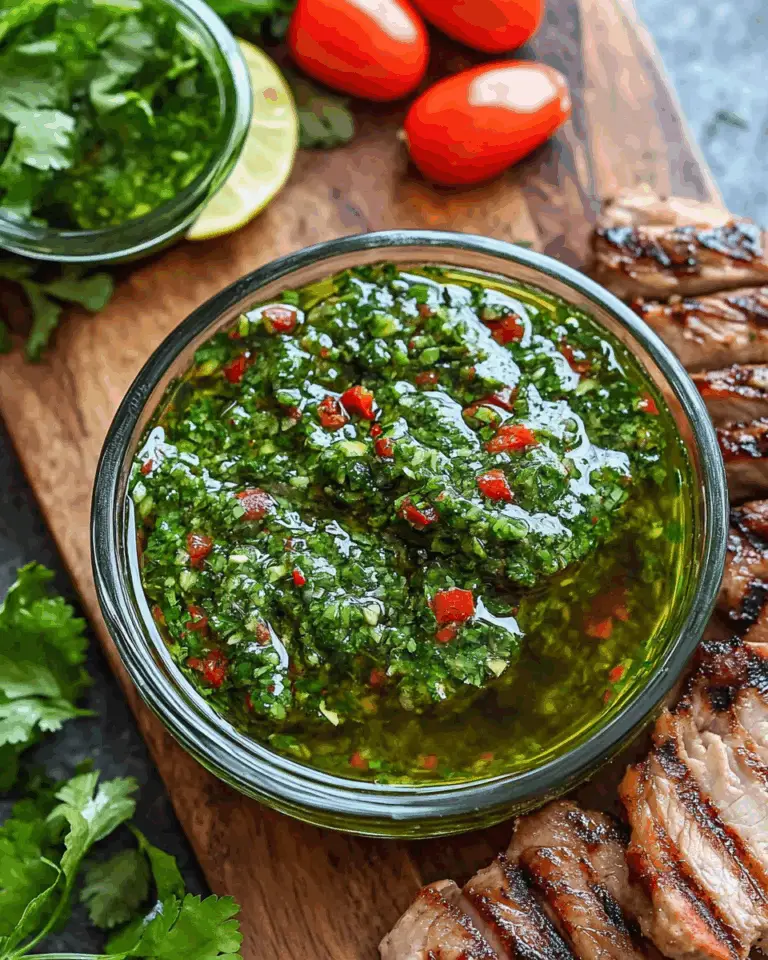Chimichurri Sauce is a vibrant and zesty South American condiment made from fresh herbs, garlic, chili, and red wine vinegar blended with olive oil. Traditionally served over grilled meats like steak or chicken, it also pairs beautifully with fish, vegetables, and even crusty bread. Quick to make and bursting with herby, tangy, and garlicky flavors, this sauce adds bold character to any savory dish and is a must-have for grilling season or everyday cooking.
Full Recipe:
Ingredients
-
2 cups lightly packed flat-leaf parsley, finely chopped
-
¼ cup lightly packed oregano leaves (or 2 tsp dried), finely chopped
-
½ red chili pepper, cored, seeded, and minced finely
-
Small pinch red pepper flakes (optional)
-
4 cloves garlic, pressed
-
½ tsp (slightly heaping) sea salt
-
Pinch black pepper
-
2 tbsp red wine vinegar
-
½ cup olive oil
Directions
Place the chopped parsley, oregano, minced chili, red pepper flakes, garlic, salt, and pepper into a mixing bowl. Add the red wine vinegar and stir with a fork to combine. Slowly drizzle in the olive oil while stirring, blending everything into a cohesive sauce. Taste and adjust seasoning as needed. Use immediately for best flavor, or store in an airtight container in the fridge for up to 4–5 days.
Nutrients
Yield: ~¾ cup
-
Serving Size: 2 tablespoons
-
Calories: 64
-
Fat: 7g
-
Carbohydrates: 1g
-
Protein: 0g
-
Fiber: <1g
-
Sugar: 0g
-
Sodium: ~100mg
A Traditional Staple with Modern Versatility
Chimichurri has long been a cornerstone of Argentinian asado culture—their style of barbecue where beef is king. In these traditional settings, chimichurri is brushed onto meat before grilling or spooned generously over grilled cuts like flank steak, ribeye, and short ribs. It’s also served as a dipping sauce on the side, allowing guests to enjoy it however they choose.
In modern kitchens, the use of chimichurri has expanded far beyond red meat. It now finds its way onto grilled chicken, roasted vegetables, shrimp, white fish, pasta salads, eggs, sandwiches, and even pizza. Its fresh herbaceousness and acidic zing make it a flexible addition to almost any meal. It’s also become a favorite marinade for proteins, adding layers of flavor without masking the natural taste of the food.
The Flavor Profile of Chimichurri
What makes chimichurri unique is its intense but balanced flavor profile. The fresh parsley forms the base, offering a grassy, slightly peppery note. Oregano adds depth, giving it a subtle woodsy aroma. Garlic brings sharpness and pungency, while red chili and optional flakes give the sauce a hint of heat without overwhelming spice. Red wine vinegar cuts through the richness of grilled meat with acidity and brightness, and olive oil pulls everything together into a smooth, pourable consistency.
This combination creates a sauce that is tangy, garlicky, slightly spicy, and incredibly herbaceous. It hits every part of the palate—making even simple dishes come alive with character.
Health Benefits of Chimichurri Sauce
Beyond its bold flavor, chimichurri is also a relatively healthy condiment. It’s made entirely from whole-food ingredients, many of which carry their own nutritional benefits. Parsley is rich in vitamin K and vitamin C and has natural anti-inflammatory properties. Garlic is well known for supporting heart health and immune function. Olive oil provides healthy monounsaturated fats, and the red chili adds a small boost of metabolism-friendly capsaicin.
Since chimichurri contains no added sugars, artificial flavors, or dairy, it’s naturally gluten-free, keto-friendly, and suitable for most clean eating plans. It’s also vegan, which makes it a fantastic choice for plant-based dishes and health-conscious eaters looking to add depth without compromising nutrition.
How to Use Chimichurri Beyond Grilled Steak
Chimichurri is most famous as a steak sauce, but that’s just the beginning. It can be spooned over grilled chicken thighs, pork chops, roasted lamb, or even pan-seared fish like salmon or cod. It’s excellent as a condiment for burgers, wraps, or sandwiches—especially when paired with grilled vegetables or cheese. Drizzle it over roasted potatoes, quinoa bowls, or couscous salads to instantly elevate the dish.
You can also use it as a salad dressing by adding a splash of lemon juice or white vinegar. Mix it with mayonnaise or yogurt for a creamy dip or spread. It even works beautifully as a marinade: just coat your protein of choice with chimichurri and let it rest in the fridge for 30 minutes to a few hours to absorb all that flavor.
Another underrated use? Dip fresh crusty bread into chimichurri as a starter—it’s a simple yet memorable way to begin any meal.
Tips for the Best Chimichurri Sauce
To make a truly great chimichurri, use fresh, high-quality ingredients. Flat-leaf parsley offers the best texture and flavor. Avoid over-mincing the herbs—they should be chopped finely but not pureed. A rustic, slightly chunky consistency provides the most traditional mouthfeel and prevents the sauce from becoming overly oily or flat in taste.
When choosing olive oil, opt for one that’s mild and fruity rather than bitter or peppery. The red wine vinegar should be sharp but balanced, and if you’re looking to enhance the flavor, a squeeze of fresh lemon juice can add an extra layer of brightness.
It’s best to prepare chimichurri fresh and let it sit for 15–20 minutes before serving to allow the flavors to meld. If you’re making it ahead of time, store it in an airtight container in the fridge and use within 4–5 days. Bring it to room temperature before serving, as the olive oil may solidify slightly when chilled.
Variations and Regional Twists
There are many ways to adapt chimichurri based on regional styles or personal preferences. Some variations include a green bell pepper or red bell pepper for sweetness and body. Others incorporate chopped shallots or red onions for added sharpness. A handful of cilantro can be added to give the sauce a more Latin American flavor, closer to Mexican salsa verde.
You can also try switching up the acid—use lemon juice or white wine vinegar in place of red wine vinegar for a slightly different tang. Want more heat? Add more red chili or even a touch of hot sauce. For a smoother texture, blend the sauce briefly in a food processor, though this is less traditional.
The beauty of chimichurri is that it can be customized without losing its essential appeal.
Why Chimichurri Should Be a Pantry Staple
Chimichurri stands out not only for its flavor but for its sheer utility in the kitchen. It can enhance grilled foods, brighten up roasted vegetables, stand in for a dressing, or serve as a quick marinade. It requires no cooking, no hard-to-find ingredients, and minimal prep time.
Because it keeps for several days in the fridge, it’s a great make-ahead component for meal prep. Just a few spoonfuls can transform a simple bowl of rice and beans, scrambled eggs, or a basic sandwich into something that tastes gourmet.
It’s also budget-friendly, requiring only herbs, garlic, vinegar, oil, and a chili or two—items that are often already on hand in most kitchens.
Conclusion
Chimichurri Sauce is much more than a steak topper—it’s a bold, zesty, and incredibly versatile condiment that deserves a permanent spot in your kitchen repertoire. With its bright herbs, pungent garlic, and tangy vinegar base, it enhances everything it touches, from grilled meats to vegetables, sandwiches, and even appetizers. Its simplicity is its strength: quick to prepare, easy to store, and endlessly adaptable.
Whether you’re grilling up a feast or looking to elevate a basic meal, chimichurri delivers freshness, flavor, and a touch of culinary magic with every spoonful. If you haven’t made it yet, now is the perfect time to embrace this classic South American staple and let it bring a vibrant new dimension to your cooking.






